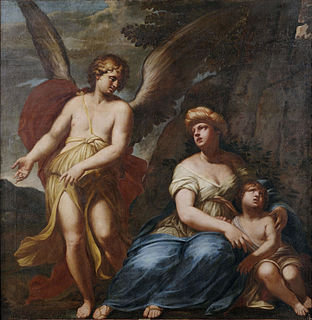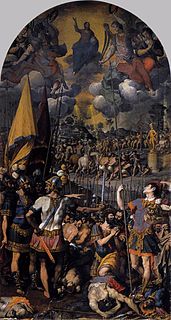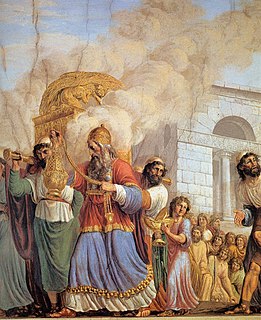
Michelangelo Cinganelli, also known as Michele Cinganelli (Florence, circa 1558 - Florence, September 26, 1635) was an Italian painter. [1]

Michelangelo Cinganelli, also known as Michele Cinganelli (Florence, circa 1558 - Florence, September 26, 1635) was an Italian painter. [1]
He was a pupil or strongly influenced by Bernardino Poccetti of Florence. Along with Orazio Riminaldi, he painted the four Evangelists and angels (1597) in the cupola of the Cathedral of Pisa; a Birth of the Virgin and Annunciation (1598) in the choir; and decoration of the organ in 1602. He also painted in the church of San Domenico, Pistoia. He is documented as working for the tapestry shop of the Medici in Florence. Cinganelli supervised the designs by Ludovico Cigoli for the principal chapel in the church of Santa Felicita in Florence, and frescoed the chapel in 1620.
His family included the artists: Camillo (painter and wood-gilder), Benedetto (son of Michelangelo), and Antonio (son of Camillo). [2]

Domenico di Michelino (1417–1491) was an Italian Renaissance painter who was born and died in Florence. His real name was Domenico di Francesco. The patronymic "di Michelino" was adopted in honor of his teacher, the cassone painter Michelino di Benedetto, by whom no works have been identified. Giorgio Vasari reports that Domenico was also a pupil of Fra Angelico, whose influence is reflected in many of Domenico's paintings along with that of Filippo Lippi and Pesellino.

Baldassare Franceschini, called Il Volterrano after his birth place Volterra and, to distinguish him from Ricciarelli, Il Volterrano Giuniore was an Italian late Baroque painter and draughtsman active principally around Florence and Volterra. He was mainly known for his frescoes, altarpieces and easel paintings for churches and palaces in Florence, Volterra and Rome. His subject matter was diverse and included portraits, biblical and mythological scenes, history paintings and allegorical compositions.

Bernardino Poccetti, also known as Barbatelli, was an Italian Mannerist painter and printmaker of etchings.

Marcello Venusti was an Italian Mannerist painter active in Rome in the mid-16th century.

Francesco Curradi or Currado was an Italian painter of the style described as Counter-Maniera or Counter-Mannerism, born and active in Florence.
Giovanni Francesco Braccioli was an Italian painter of the Baroque period, mainly active in Ferrara.
Clemente Bocciardo (1620–1658) was an Italian painter of the Baroque. He was born in Genoa. He was also called Clementone because of his large size. He was a pupil of Bernardo Strozzi and accompanied Giovanni Benedetto Castiglione to Rome. He painted a Martyrdom of St. Sebastian for the church of the Carthusians in Pisa. Also painted in Florence.

Giuseppe Nicola Nasini was an Italian painter of the Baroque period, active in Rome and Tuscany.

Giuseppe Diamantini was an Italian painter and printmaker of the Baroque period, active mainly in Venice. Some sources cite varying dates for his life span including 1660-1722.

Filippo Maria Galletti (1636–1714) was an Italian painter of the Baroque period, active mainly in Tuscany, Parma, and Liguria. He was a pupil of the painter Ciro Ferri and Pietro Dandini. He became a Theatine priest, and painted religious works in Lecce and Livorno, and the church of Santa Lucia (Parma). He entered the Theatine order.

Hendrick van den Broeck or Arrigo Fiammingo was a Flemish painter, fresco painter, glass painter and sculptor of the late-Renaissance or Mannerist period. After training in Flanders, he travelled to Italy where he remained active in various cities for the remainder of his life. He was court painter to Cosimo I de Medici in Florence and worked as a fresco painter in Rome on the large decorative projects of pope Gregory XIII.
Giacomo Alboresi (1632–1677) was an Italian painter of the Baroque period.
Giovanni Battista Buonocore was an Italian painter of the Baroque period. He became Rector (1679), then Principe (1698) of the Accademia di San Luca of Rome.

Romulo Cincinato or Cincinnato was an Italian painter of the Renaissance period, active in Spain after 1567. His two sons, Diego and Francisco Romulo were painters in Spain.

Michelangelo had a complicated relationship with the Medici family, who were for most of his lifetime the effective rulers of his home city of Florence. The Medici rose to prominence as Florence's preeminent bankers. They amassed a sizable fortune some of which was used for patronage of the arts. Michelangelo's first contact with the Medici family began early as a talented teenage apprentice of the Florentine painter Domenico Ghirlandaio. Following his initial work for Lorenzo de' Medici, Michelangelo's interactions with the family continued for decades including the Medici papacies of Pope Leo X and Pope Clement VII.

Francesco Saverio Altamura was an Italian painter, known for Romantic style canvases depicting mainly historical events.

Luigi Ademollo was an Italian painter.
Nicola or Niccolò Contestabili was an Italian painter, mainly depicting history and landscapes in a Neoclassic style.

Giovanni Maria Ciocchi was an Italian painter and art critic, active during the Baroque period. He was born into a family of artists, and it is not clear if he is related to Giovanni Maria Ciocchi del Monte from Perugia, who became Pope Julius III. it is not clear that Giovanni Maria is related to the 16th century painter Ulisse Ciocchi.

Camillo Camilliani was an Italian architect, military engineer and sculptor. He is mostly known for the design of watchtowers and other fortifications around the coasts of Sicily.
| Wikimedia Commons has media related to Michelangelo Cinganelli . |
| | This article about an Italian painter born in the 17th century is a stub. You can help Wikipedia by expanding it. |